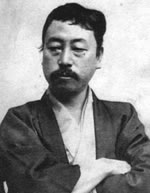
D. Sources of Influence and Transmission
16. Okakura, Kakuzô. Works 1903~06.
 |
||
| Author of the earliest lucid
English-language accounts of Zen Buddhism and its relation to the
arts, Okakura Kakuzô, ca. 1903. Image: |
Okakura’s Ideals of the East, with Special Reference to the Art of Japan (London: Murray, 1903) and The Book of Tea (London: Putnam, 1906) have been among the most widely-read English works about Japan, and their influence in shaping Western understanding of the internal consistencies and strengths of East Asian aesthetic traditions has been profound. Several points might be raised about reverberations from Okakura’s work in later English-language writing, but perhaps the most important in the context of this study is that Ideals and The Book of Tea taken either together or separately provide the earliest lucid English-language account of Zen Buddhism and its relation to the arts, a subject developed, largely in the terms Okakura establishes, by Binyon in Japanese Art (BC6, 1909), Okakura’s teacher Fenollosa in Epochs of Chinese and Japanese Art (10c, 1911), Waley in Zen Buddhism and Its Relation to Art (see 26, 1922), and even in the later definitions of Western understanding of Zen by Suzuki (see D28). Binyon’s earliest publication about a Japanese subject (BC1, 1903) is a review of Ideals, which he finds of ‘extraordinary interest’. He acknowledges the work as a source for Painting in the Far East (BC2), The Book of Tea as a source for Flight of the Dragon (BC9), and as late as 1935 begins the second of his Charles Eliot Norton lectures at Harvard (see BC27) with Okakura’s opening assertion in Ideals, that ‘Asia is one’, and moves on in the third to a discussion of Zen that has its roots in Okakura’s writing. Ficke acknowledges Okakura as a source for his Chats on Japanese Prints (BG5), Fletcher for his ‘Secret of Far Eastern Painting’ (BH5), and Stevens, who read Ideals in 1909, refers to the work in a letter and diary entries that identify it with ukiyoe and his own early experiments with colour imagery (see CA7). The importance of Okakura’s writing as a source of Western understanding of Japan is discussed by Hall (A16), Ennis (A22), and Walsh (BK176a). Ideals, The Book of Tea, and The Awakening of Japan (Murray, 1904) are collected in Okakura’s Collected English Writings, edited by Sunao Nakamura (Tokyo: Heibonsha, 1985). See also Victoria Weston, Japanese Painting and National Identity: Okakura Tenshin and His Circle (Ann Arbor: Center for Japanese Studies, University of Michigan, 2004); Yasuko Horioka, The Life of Kakuzô, Author of The Book of Tea (Tokyo: Hokuseido, 1963); Satoko Fujita Tachiki, Okakura Kakuzô and Boston Brahmins (PhD thesis, University of Michigan, 1986; abstract in DAI 47/3: 1026A); and BK177a, CC2, 3, and D10c.































